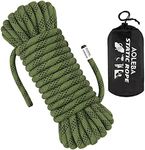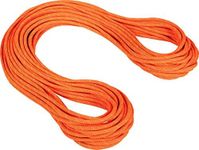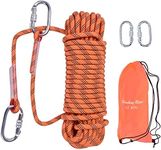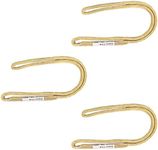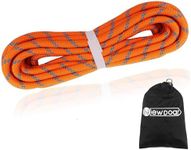Buying Guide for the Best Climbing Ropes
Choosing the right climbing rope is crucial for your safety and performance while climbing. The right rope can make a significant difference in your climbing experience, whether you're a beginner or an experienced climber. When selecting a climbing rope, consider the type of climbing you will be doing, the frequency of use, and your personal preferences. Here are some key specifications to help you make an informed decision.DiameterThe diameter of a climbing rope affects its weight, durability, and handling. Thicker ropes (around 10-11mm) are more durable and better for top-roping and gym climbing, as they can withstand more wear and tear. Medium diameter ropes (9.5-10mm) offer a balance between durability and weight, making them suitable for sport climbing and trad climbing. Thinner ropes (8.9-9.4mm) are lighter and more suitable for advanced climbers who need to reduce weight for long routes or alpine climbing. Choose a diameter based on your climbing style and the level of durability you need.
LengthThe length of a climbing rope determines how far you can climb and how much rope you have for belaying. Standard rope lengths are 60m and 70m, with 70m ropes becoming more popular for longer sport routes. Shorter ropes (30-50m) are suitable for gym climbing or shorter outdoor routes. Consider the typical length of the routes you climb and choose a rope length that provides enough reach while minimizing excess weight.
Type (Single, Half, Twin)Climbing ropes come in different types: single, half, and twin ropes. Single ropes are the most common and versatile, suitable for most types of climbing, including sport, trad, and top-roping. Half ropes are used in pairs and are ideal for trad and alpine climbing, where you need to reduce rope drag and have redundancy. Twin ropes are also used in pairs but must be clipped together into each piece of protection, making them suitable for ice climbing and mountaineering. Choose the rope type based on the climbing activities you plan to engage in.
Dry TreatmentDry treatment refers to a coating applied to the rope to repel water and dirt. This is important for climbing in wet or snowy conditions, as a wet rope can become heavy and lose strength. Dry-treated ropes are more expensive but offer better performance and longevity in adverse conditions. If you primarily climb in dry conditions, a non-dry rope may suffice. However, if you climb in variable weather or alpine environments, a dry-treated rope is a better choice.
WeightThe weight of a climbing rope is usually measured in grams per meter (g/m). Lighter ropes are easier to carry and handle, making them ideal for long routes and alpine climbing. Heavier ropes are more durable and better suited for frequent use and top-roping. Consider the balance between weight and durability based on your climbing needs. If you prioritize lightweight gear for long ascents, opt for a lighter rope. For frequent gym or sport climbing, a heavier, more durable rope may be more appropriate.
Impact ForceImpact force is the amount of force transmitted to the climber and protection during a fall. Lower impact force means a softer catch, which is gentler on the climber and the gear. Ropes with lower impact force are beneficial for trad climbing, where protection may be less secure. For sport climbing, where falls are more frequent and protection is stronger, a higher impact force may be acceptable. Choose a rope with an impact force that matches your climbing style and the type of protection you use.
UIAA Falls RatingThe UIAA falls rating indicates the number of falls a rope can withstand before it is likely to fail. This rating is a measure of the rope's durability and safety. A higher falls rating means the rope can endure more falls, making it more suitable for frequent climbing and lead climbing. For occasional climbers or those who primarily top-rope, a lower falls rating may be sufficient. Consider your climbing frequency and the type of falls you expect when choosing a rope with an appropriate falls rating.
